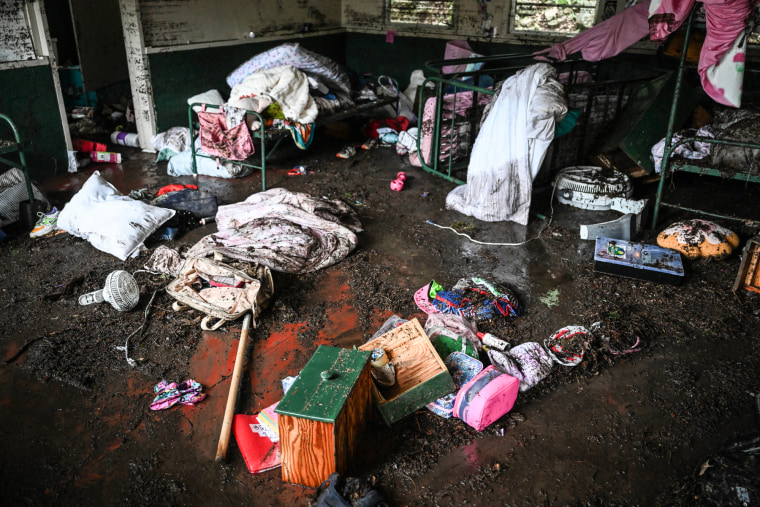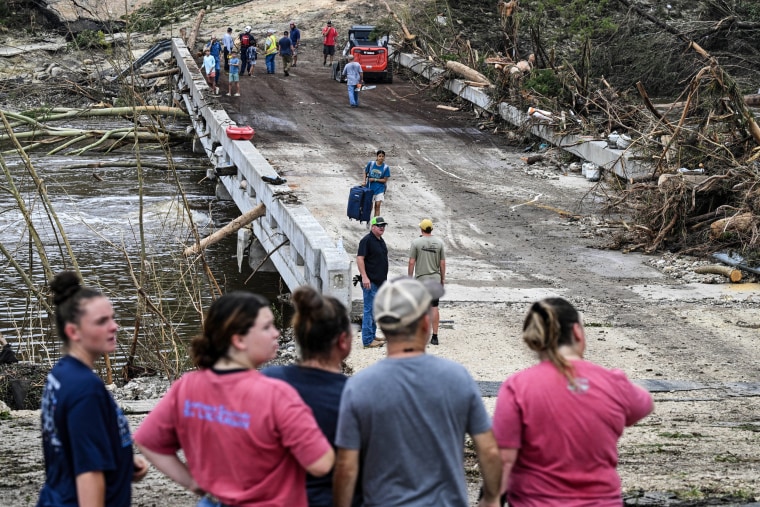INGRAM, Texas — Samuel Cummings spent much of Monday wading through knee-high floodwaters, trudging across muddy fields, digging into mounds of dirt and slashing through thickets of brush with a chain saw.
But the physical demands of the search and recovery efforts near flood-battered Kerrville were nothing compared with the emotional gut punch of what Cummings saw strewn underfoot: girls’ Crocs and tennis shoes, volleyballs and water bottles.
The objects are the tragic remnants of Camp Mystic, where 27 girls and counselors died in flash floods that ripped through Central Texas over the weekend, leaving at least 104 people dead or missing across six counties.
“That’s where you start to get choked up,” said Cummings, who spoke to NBC News roughly 5 miles downstream of Camp Mystic as helicopters circled overhead.
Cummings, 22, a recent college graduate who lives in Corpus Christi, jumped in his Ford truck and headed straight for the flood-ravaged region Sunday night. He grew up in Kerrville and swam in the Guadalupe River as a kid.
He wanted to help. He felt he had no choice.

The monstrous floods abruptly tore through West Texas overnight Friday during the Fourth of July holiday weekend, inundating buildings, trapping residents in their homes and leaving a trail of death in their wake.
These Texas Hill country communities are usually an oasis of trees and water for many who come from the congested, busier cities of Houston, Dallas, Austin and San Antonio, as well as other parts of the country.
Now, the serenity some seek here is broken up by the buzz of chain saws and whoop-whoop-whoop of helicopter blades, including an occasional military Chinook.
Soggy tree bark, hefty branches and whole tree trunks are smashed up against railings, homes, and whatever else stood in the water’s path but didn’t collapse from its force. The Guadalupe River water surrounds trees that once stood on solid ground, with many now bowed against each other like a stack of dominoes.
Local residents wear faces of shock and sadness as they take in the destruction. Landmarks like the shops in Old Ingram Loop were nearly emptied by the river, refilled with mud or splintered to pieces.
Amid the devastation, first responders and volunteers trudge into muck and mud, scramble over debris piles and check emotions to poke and prod and chop and saw in search of still-missing victims.
Brandie Masters, who lives in nearby Mountain Head with her husband, Jared, felt it was her responsibility to assist in the aftermath.
Jared spent part of Monday behind the wheel of an excavator, digging through “piles and piles and piles” of debris, Masters said. She stayed on foot, scouring the muck for any signs of life.
She hasn’t yet found any bodies, but she has encountered grim reminders of the young lives lost: kayaks, sports gear, little girls’ clothes.
Masters, 42, doesn’t know when she and Jared will return home. They plan to “stay as long as it takes.” They might sleep in their car overnight.
“A lot of men are out here working really hard to recover families,” Masters said. “God is ultimately in control. Everyone just needs to pray.”
Dennis Price, founder and CEO of Heroes for Humanity, a nonprofit organization that sends out veterans, first responders, medical personnel and other crews after disasters, described surreal scenes, including a dead cow stuck high in a tree.
Price also saw “60 to 80 RVs pinned up against trees,” some stacked “about 20 feet high with fallen trees, other debris and just pieces of vehicles smashed up, torn up and then flipped over.”
He said his volunteers in the hardest-hit areas told him Monday they found two pairs of bodies as part of their rescue and recovery efforts. One of the team members put on his amphibious gear and “went down into a river and pulled out two family members.”

Two more people were found along the riverbank, he said.
“It’s a massive tragedy. We feel for the families. We feel for all these people, and we keep them in our prayers. That’s why we support every way we can,” he said.
Mark Edwards, field operations manager for the nonprofit group Texas EquuSearch, deployed more than 120 trained volunteers on horseback, in ATVs and on foot to look for survivors and victims. The team included Robert Crow, a member of Tejas Vaqueros, a riding group from Houston.
“I have two daughters. I know what it feels like. I don’t know what it feels like to lose them,” Crow said as he threw blankets over his horse, Peaches.
Edwards is an experienced search-and-rescue professional whose teams coordinate with law enforcement. But disaster aftermath still takes an emotional toll, he said, even if it takes some time to absorb.
“I’ve learned to have a trigger switch. I’ll fall apart later,” Edwards said.
Suzanne Gamboa reported from Ingram, Daniel Arkin from Los Angeles and Daniella Silva from New York.
